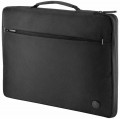The maximum diagonal size of a laptop that can be carried in a bag. Traditionally measured in inches (''). Often the maximum size is at the same time optimal, that is, the one for which the bag was originally designed: a laptop of this size will “sit” in the mounts as tightly as possible without hanging out. At the same time, most bags allow you to transport laptops with a diagonal smaller than the maximum size — though not by much, usually by 1-2".
Now on the market, there are bags for all diagonals of laptops:
10",
11",
12",
13",
14",
15",
16",
17".
—
Cloth. Bags made of soft fabric (type unknown). Such material is inexpensive, strong enough, often made waterproof and well suited for everyday use, even in rather harsh conditions. The fabric is cleaned with a normal wash.
—
Polyester. Synthetic fibre based on polyester is characterized by good strength, resistance to moisture, ultraviolet radiation and temperature extremes, and at the same time it is relatively inexpensive. True, the specific degree of strength and durability depends on the grade of polyester: the more expensive, the more reliable the material, usually.
—
Nylon. Another type of synthetic fibre, similar in basic properties to polyester. The term "nylon" can mean different types of polymers and, accordingly, the quality of this material can also be different — from a relatively short-lived fabric that is not intended for difficult conditions, to high-end solutions like Cordura. Usually the properties of nylon are directly related to the price category of the bag.
—
Skin. Genuine leather can be called a fashion material; bags made of it look especially stylish and solid. In addition to these advantages, the skin is durable, resistant to temperature extremes and does not let water through. The disadvantages, in addition to the high price, include, first of all, the need for special care — pro
...cessing with special means, careful drying — otherwise the skin will crack and deform. In addition, leather products are prone to scratches.
— Leatherette. This is an option for those for whom genuine leather products are too expensive — leatherette can be almost indistinguishable from it in appearance, but it costs much less. In addition, care for such products is somewhat easier than for leather. On the other hand, leather substitutes are less resistant to stress, are sensitive to temperature changes, and scuffs appear on them faster. Usually, the quality (and, accordingly, the service life) of a leather substitute is directly related to its price.
— Plastic. Rigid material used in various types of bags. It has average strength characteristics, it can quite well protect the contents of the bag from impacts (although it cannot withstand strong impacts — it cracks); in addition, it is waterproof, resistant to deformations and temperature changes, and also inexpensive.
— Metal. The main advantages of metal are high strength, reliability and hardness. This material perfectly protects the equipment inside, it endures even quite strong pressures and blows without consequences. On the other hand, metal cases (usually these are cases) are not cheap, and the mentioned strength is rarely critical — simpler materials, like the same plastic, are often enough for domestic use. Therefore, this option is not particularly popular. Note also that the composition of the metal can be different. The most widely used steel and aluminium alloy; they are approximately the same in strength, while aluminium is noticeably lighter, but also more expensive than steel.
— Rubber. In this case, both rubber itself and other materials with similar properties — soft and elastic (for example, silicone) can be implied. However, these materials are predominantly used for covers (see "Type"), with some of these products designed to be permanently worn on a laptop. The softness gives the rubber some shock-resistant properties, but covers made of this material are usually designed not so much for serious protection, but rather to withstand minor household "troubles" like accidental scratches.
